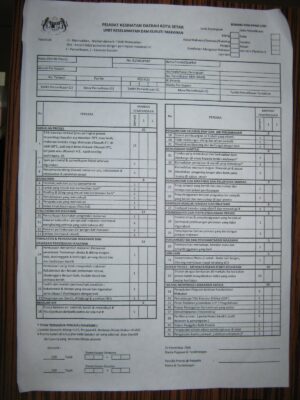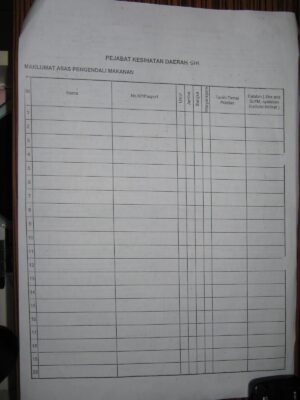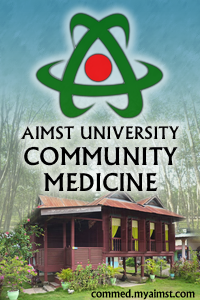Mr. Dzullkifri, PPKP supposed to come and give us a talk on Food Quality Control,but he was busy with the food premise operation, at the end, Mr. Asri, another PPKP of Unit KKM came to replace him.
The objective of KKM is to make sure all the food that are supplied to the community are safe, including those food are imported and exported, teach and encourage the commity to buy the safety and nutritonal food.
Specific objectives are:
- Make sure all the food that sold to the public followed the standardized protocol, free of food contamination, contain labelling and advertising correct information of the food (do not confuse the public of that food).
- Make sure food that is prepared, stored, sold and managed in a proper and clean condition.
- Make sure the consumer understands the explanation on health education on food quality control.
- Make sure all the food that are prepared always free of contamination and put into practise on the way to preserve the food.
Activities & Resposibilities :
- Inspection of food premises
- Closing food premises below standard
- Food Sampling ( Physical, Chemical, Microbiology )
- Confiscation Operation, especially in response to ‘food alert’ eg. Confiscation of all products containing Melamine.
- Disposal of food substances that do not fulfill Food Act 1983 and Food Regulation 1985
- Mineral Water Licensing
- Bottled Drinking Water Licensing
- Issue Health Certificate for export products
- Investigation of Food poisoning
- Investigation of spoilt/ contaminated / expired food complaints
- Give the admission letter for Anti-typhoid Vaccination for all food handlers ( RM 20 , immunity for 3 years , done every Thursday )
- Monitor food quality and hygiene in public occasions / gathering
- Preparation of monthly and annual reports
- Investigation and prosecution
- Enact the Food Act 1983 and Food Regulation 1985
- Health Education to the food premise owner
The Food Safety & Quality Unit comes under the jurisdiction of the following laws:
- AKTA MAKANAN 1983 (AKTA 281)
- PERATURAN-PERATURAN MAKANAN 1985
- KANUN ACARA JENAYAH
- KOD AMALI KEBERSIHAN MAKANAN
- KOD AMALI KEBERSIHAN PEMPROSESAN UDANG BEKU
- PERATURAN-PERATURAN KAWALAN HASIL TEMBAKAU 1993
- AKTA JALAN PARIT DAN BANGUNAN 1974
- UNDANG-UNDANG KECIL BANGUNAN SERAGAM 1984
Based on the targets set by the Kedah Health Department, the unit is required to monitor at least 1450 food premises and take 1300 food samples each year. The action plan includes:
- Decreasing the incidence of food poisoning in schools / institutions
- To ensure food handlers comply with the required food standard and safety.
INSPECTION OF FOOD PREMISE
Last week 7/7/2010 , KKM from various district, including the Sik unit KKM had the Food Premise Operation Spot Check that is held annually, this is Operation VII. According to Mr. Asri , it supposed to be Operation VIII, the reason is that previous District Health Officer cancelled the activity. The reason that KKM from other district come to have operation together is to make sure that the PPKP does their job, because they know all the food premise owner, it is very difficult to ‘compound’ them.
Basically, a merit system encompassing various criteria is used to assess the food safety and quality:
- KMM 3P1 ( Restaurants/Food outlets/Kitchen)
- KMM 3P2 ( Food Stalls / Canteen)
- KMM 3P3 ( Stationary hawkers )
HOWEVER, it is replaced by the new merit system which standardize the assessment of food saftet and quality. In short, the 3 forms stated above are combined into 1 paper.
BORANG KKM-
PPKM-2/09 (please magnify to see the content)
Food premises that fail to meet the required standard will be issued a closing order, as stated in Section 11, Food Act 1983 and order to clean the food premise. Closing order will be issued if the total score is less than 70% for schools and less than 60% for all other eateries. Lampiran 1 form is issued to close the premise.
In the event of borderline scores, the premise will be issued with warning letter (Lampiran 2) to increase the hygiene level and subsequent inspection will be done to assess the improvements, failure of which will result in the closure of the premise.
In addition to that, Sealing / Freezing and Disposal of food substances will be done based on Standard Operating Proceduring.Within this 2 weeks, food premise owner should clean the premise and call for PPKP to re-open their shop.
Food Premise Inspection Protocols
The spot check team should consist of various members from various district. This will prevent bias in the decision making whether need to ‘compound’ the owner or not.
Firstly, PK (Pegawai Kesihatan or Health Officer) will check the food premises registry. Vaccination for anti-typhoid will be taken into consideration. If the owner does not take the vaccine, they will be warned to do so. PPKP will classify premises according to Colour tag Lot system. PK will isolate the premise into the inspection plan.PPKP identify the premise to be inspected, he is the one who determine which premise to be inspected.
During the Food Premise Inspection, I followed Mr. Dzullkrifi, some cases he selected were ‘old case’, however, most of the premises he pass by, he will stop and spot check. PPKP will prepare the equipment ( based on check list ), he then enter the premise and introduce himself and show the prove he is health inspector, present official power card and explain the purpose they come. Collection of information will be done. PK will inspect the food premise. They will identify the faults and verify the complaints. Photographs of the unhygienic environment and other problems are taken. PPKP will fill in the form and judge whether to compound the owner.
If sampling is required:
- If sample is taken, explain to the owner/representative about the sample taken for analysis.
- Give a copy of the inspection report to the owner/representative.
- If sample is taken, send the sample for analysis and get formal reply from the lab declaring the reception of the samples.
- Photos taken are sent for developing.
- Prepare official report including the analysis findings and photographs.
- Submit report to PKP.
- Submit report to the person who made the complaint ( If necessary ).
- Submit report and ID to the Investigation officer ( UPPD ) if inspection is associated with investigation.
- Record and store exhibit in safe place.
- Enter the report into the file ( open new file if the premise is new and register the premise into the premise registry)
- Colour tagging for the file.
- Written record
FOOD SAMPLING PROTOCOL
According to the target set by State Health Office, for example, the target is benzoic acid. PPKP will do his homework to find out what are the food contain benzoic acid. – eg. chilli sauce.
PPKP will enter the shop and introduce himself and show the prove he is health inspector, present official power card and explain the purpose they come. He will choose the food needed to be sampled (that contain benzoic acid). Then, he will make the payment for the thing he buy and get a receipt (penjual) or surat akuan sampling ( pengilang/pengimport). Sampling conduted based on Food Rules and Regulation 1985.
Sample is sealed and labelled. 3 similar samples offered to the owner and make him choose 1 for him to keep. He will release sample collection notice as per section6(1) food act 1985.Other 2 samples are taken back to the office. Record sample details in the record book and prepare analysis request form. He will send 1 sample and along with this form (Borang A) to a lab(look for physical and chemical investigations) authorized by the officer in charge or through registered AR post and get a conformation letter from the lab once they have received the sample. He will select the content to be tested. For example, chilli sauce, he will choose to test concentration of benzoic acid.If the result is positive showing food does not fulfilled the requirement, result will be sent within 9days. Otherwise, Lab will send the result within 90 days. The 3rd sample is kept locked in a cabinet.
As for microbiological investigation, procedure almost the same, except Place the sample in the fridge filled with ice or cold packs. Date, time and temperature are recorded.Prepare analysis request form and send sample to an authorized lab immediately.Get a conformation letter from the lab once they have received the sample. Record the date, time and temperature.Record and update written record.
By Jun Sian
Source: mbbs12sik.blogspot.com




